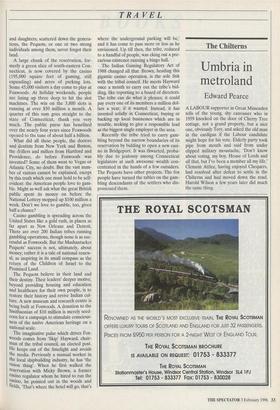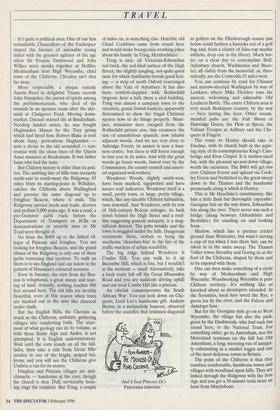The Chilterns
Umbria in metroland
Edward Pearce
A LABOUR supporter in Great Missenden tells of the young, shy canvasser who in 1959 knocked on the door of Cherry Tree cottage, not a grand property, but a nice one, obviously Tory, and asked the old man in the cardigan if the Labour candidate might hope for his vote. Elderly party took pipe from mouth and said from under clipped military moustache, 'Don't know about voting, my boy, House of Lords and all that, but I've been a member all my life.' Clement Attlee, having enjoyed Chequers, had resolved after defeat to settle in the Chiltems and had moved down the road. Harold Wilson a few years later did much the same thing. It's quite a political area. One of our less remarkable Chancellors of the Exchequer shared the favours of amenable young ladies with the greatest agitator of the age when Sir Francis Dashwood and John Wilkes were monks together at Hellfire Medmenham near High Wycombe, chief town of the Chilterns. Cliveden isn't that far away.
More respectably, a plaque outside Austin Reed in. delightful Thame records John Hampden, the purest of spirits among the parliamentarians, who died of his wounds in an upstairs room after the skir- mish at Chalgrove Field. Moving down- market, Disraeli started life at Bradenham. Needing landed status, he was bought Hughenden Manor by the Tory group which had hired him. Robert Blake is cool about fussy, pretentious Hughenden now a shrine to the old scoundrel — con- trasted with the clean lines of the Queen Anne mansion at Bradenham. It was father Isaac who had the taste.
But Chiltern history is older than its poli- tics. The ambling line of hills runs inexactly north-east to south-west; the Ridgeway, 85 miles from its starting-point in Wiltshire, catches the Chilterns above Wallingford and pursues the same diagonal up to Ivinghoe Beacon, where it ends. The Ridgeway carried herds and trade, drovers and pedlars 5,000 years ago. It was a road, a pre-Gummer earth track, before the Department of Transport or JCBs or demonstrations or security men or Mr Toad were thought of.
Go from the B489 up to the linked vil- lages of Pitstone and Ivinghoe. You are looking for Ivinghoe Beacon, and the grand climax of the Ridgeway is only one of three paths traversing that territory. To walk on them is to see England laid out below in the pattern of Housman's coloured counties.
Even in January, the view from the Bea- con is voluptuous, a great sweep and soar- ing of land. Actually, nothing reaches 900 feet around here. The old hills are lavishly beautiful, even at this season when trees are marked out in the mist like charcoal under chalk.
But the English Hills, the Cheviots as much as the Chilterns, undulate, gathering villages into comforting folds. The utter- most of what geology can do by volume, as with those flashy Alps and Andes, is not attempted. It is English understatement. Wait until the corn stands on all the hill- sides, then take a ride from Great Mis- senden in one of the bright, striped bal- loons, and you will see the Chilterns give Umbria a run for its money.
Ivinghoe and Pitstone villages are anti- climactic — handsome at the core, though the church is shut. Dull, serviceable hous- ing rings the outskirts. But Tring, a couple of miles on, is something else. Horrible old Claud Cockburn came from round here and would make bourgeoisie-crushing jokes about his family 'in Tring, Hertfordshire'.
Tring is nice, all Victorian-Edwardian red brick, the red-tiled surface of the High Street, the slightly jangling, not-quite-good taste for which familiarity breeds good feel- ing — a strip of north Oxford rearranged above the Vale of Aylesbury. It has also been confetti-dappled with Rothschild largesse: here a hall, there a civil building. Tring was almost a company town to the eccentric, genial Jewish bankers, apparently determined to show the frugal Christian squires how to do things properly. Munt- jacs, miniature deer escaped from the Rothschild private zoo, tiny creatures the size of unambitious spaniels, now inhabit adjacent woods. And we are very close to Ashridge Forest; its manor is now a busi- ness centre, but there is still forest enough to lose you in its aisles. And with the great woods go lesser woods, fussed over by the Commission, the county council and assort- ed organised well-wishers.
Wendover Woods, slightly south-west, have been marked, signposted and have nature trail indicators. Wendover itself is a small, pretty town, or large, pretty village, which, like any sizeable Chiltern habitation, runs downhill. And Wendover, with its row of 16th-century Boleyn cottages, its back street behind the High Street and a roof- line suggesting general antiquity, is a mag- nificent descent. The pubs twinkle and the town is snuggled under the hills. Dangerous sentiments these, certain to bring the anathema 'chocolate-box' to the lips of the traffic wardens of urban sensibility.
The big ridge behind Wendover is Combe Hill. You can walk to it up Bacombe Hill, which is fine, but I wouldn't at the moment — mud! Alternatively, take a back route left off the Great Missenden Road and you are suddenly driving uphill and can treat Combe Hill like a plateau.
An obelisk commemorates the South African War. You can look down on Che- quers, Lord Lee's handsome gift. Andrew Brown, in a melancholy humour, observed before the ceasefire that Irishmen disguised And it beat Princess Di's Panorama interview.' as golfers on the Ellesborough course just below could fashion a bazooka out of a golf bag and, from a cluster of false-top mashie niblicks, drop one in the library. Much bet- ter on a clear day to contemplate Brill, Aylesbury church, Waddesdon and Bices- ter, all visible from the memorial, as, theo- retically, are the Cotswolds 55 miles west.
You can continue by road for Chinnor and narrow-streeted Watlington by way of Lewknor, where Mike Fletcher runs the ancient, welcoming and admirable Old Leathern Bottle. The entire Chiltern area is very much Brakspear country, by the way — beer tasting like beer. Other recom- mended pubs are the Full Moon at Hawridge Green, the Plow at Speen, the Valiant Trooper at Aldbury and the Che- quers at Fingest.
The route to Henley should take in Ewelme, with its church built in the aspir- ing style of its contemporaries King's Cam- bridge and Eton Chapel. It is modest-sized but, with the pleasant up-and-down village, worth the excursion. The B481 will get you over Chiltern Forest and upland via Cook- ley Green and Nettlebed to the great sweep down to the Thames and the handsome promenade along it which is Henley.
This is Mr Heseltine's constituency, like him a little flash but thoroughly enjoyable: Georgian bits on the way down, Edwardian bits along the river. There never was such a bridge (slung between Oxfordshire and Berkshire) for standing on and looking from.
Marlow, which has a prettier cricket ground than Worcester, but wasn't serving a cup of tea when I was there last, can be taken in in the same sweep. The Thames Valley towns Streatley and Goring sit at the foot of the Chilterns, shaped by them and to be enjoyed with them.
One can then make something of a circle by way of Medmenham and High Wycombe. Woodworking Wycombe is pure Chiltern territory. It's nothing like as knocked about as developers intended. In the Seventies, local fury saved the Rye, a green lea by the river, and the Falcon and Antelope Inns.
But for the Georgian style go on to West Wycombe, the village but also the park, given by the Dashwoods, who had such fun round here, to the National Trust. For something older, go to Amersham, not the Metroland terminus on the hill but Old Amersham, a long, wavering run of antiqui- ty culminating in a market loggia and one of the most delicious towns in Britain.
The point of the Chilterns is that they combine comfortable, handsome towns and villages with woodland upon hills. They are linked through the Ridgeway with the Iron Age and you get a 50-minute train twice an hour from Marylebone.



































































 Previous page
Previous page